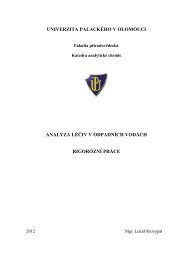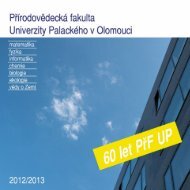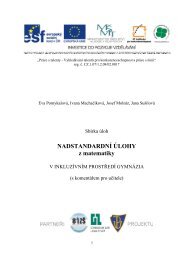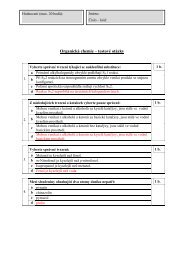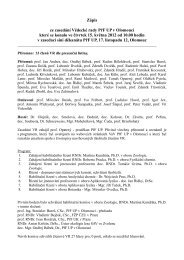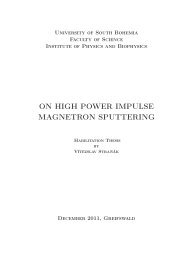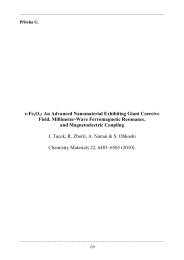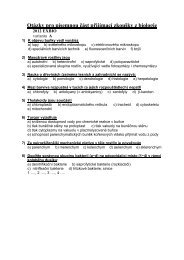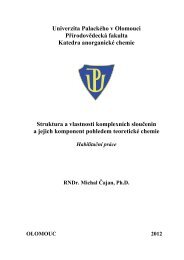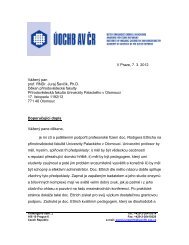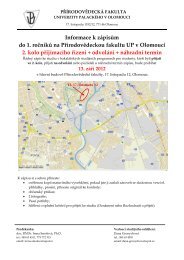A comparative structural analysis of direct and indirect shoot ...
A comparative structural analysis of direct and indirect shoot ...
A comparative structural analysis of direct and indirect shoot ...
Create successful ePaper yourself
Turn your PDF publications into a flip-book with our unique Google optimized e-Paper software.
52 M. Volgger et al.<br />
Fig. 1 Zones <strong>of</strong> a growing<br />
root hair: basal zone close to the<br />
rhizodermis (a), vacuolation<br />
zone (b), tip zone with<br />
clear zone at the very front (c).<br />
Bar 10 μm<br />
pectins, hemicelluloses <strong>and</strong> polygalacturonic acid (McNeil<br />
et al. 1984; Varner<strong>and</strong>Lin1989) fuse with the existing<br />
plasma membrane <strong>and</strong> deposit their content towards the<br />
outside <strong>of</strong> the growing cell by exocytosis. At the same time,<br />
excess membrane material is recycled by endocytotic<br />
processes (Ovečka et al. 2005). In addition, some callose<br />
<strong>and</strong> cellulose depositions were observed after staining with<br />
aniline blue (callose) <strong>and</strong> calco fluor white (cellulose) (Strobl<br />
<strong>and</strong> Lichtscheidl 2004). The subapex contains larger cell<br />
organelles <strong>and</strong> compartments like endoplasmatic reticulum<br />
(ER), mitochondria <strong>and</strong> Golgi stacks. The cell walls on the<br />
flanks <strong>of</strong> the root hairs are thicker <strong>and</strong> less plastic than at the<br />
dome. At the sides, cellulose micr<strong>of</strong>ibrils form primary <strong>and</strong><br />
then secondary cellulose textures that support <strong>and</strong> restrain the<br />
growing root hair (Schröter <strong>and</strong> Sievers 1971; Schnepf et al.<br />
1986). (2) In the vacuolation zone, the central vacuole fills<br />
most <strong>of</strong> the cell <strong>and</strong>, except for some cytoplasmic str<strong>and</strong>s, the<br />
cytoplasm is pushed towards the side walls. Here, organelles<br />
show a rotational streaming. It is postulated that turgor<br />
pressure <strong>of</strong> the vacuole is the driving force for cell expansion<br />
in general <strong>and</strong> tip growth in particular. (3) The basal zone <strong>of</strong><br />
the root hair lies close to the rhizodermis. The vacuole<br />
completely fills also this part <strong>of</strong> the root hair, <strong>and</strong> the thin<br />
layer <strong>of</strong> cytoplasm is pushed towards the cell wall.<br />
Cell wall formation under reduced turgor<br />
Turgor pressure <strong>of</strong> the vacuole can be reduced under osmotic<br />
stress conditions, as induced by freezing, drought or soil<br />
salinity. Are tip growth <strong>and</strong> cell wall formation still possible in<br />
a turgorless state? Here, this situation is simulated by<br />
plasmolysis (de Vries 1877; Oparka1994). The hypertonic<br />
(plasmolytic) solution osmotically extracts water from the<br />
vacuole up to a point <strong>of</strong> complete turgor loss <strong>and</strong>, depending<br />
on the concentration <strong>of</strong> the solution, can even cause the<br />
detachment <strong>of</strong> the living protoplast from the cell wall<br />
(Schnepf et al. 1986; Lang-Pauluzzi 2000). Thin, threadlike<br />
connections have been observed between the protoplast <strong>and</strong><br />
the cell wall <strong>of</strong> plasmolysed cells. These connections are<br />
named after Hecht (1912) <strong>and</strong> are referred to as Hechtian<br />
str<strong>and</strong>s (Sitte 1963; Schnepf et al. 1986; Oparkaetal.1996;<br />
Bachewich <strong>and</strong> Heath 1997; Lang-Pauluzzi <strong>and</strong> Gunning<br />
2000;Langetal.2004;DeBoltetal.2007). At the cell wall <strong>of</strong><br />
plasmolysed plant cells, Hechtian str<strong>and</strong>s pass into a cortical<br />
network, the Hechtian reticulation (Pont-Lezica et al. 1993)<br />
that reminds <strong>of</strong> cortical endoplasmatic reticulum. Studies by<br />
Oparka et al. (1993, 1996) on plasmolysed onion epidermal<br />
cells demonstrated that, although the cortical ER remained<br />
strongly attached to the cell wall, it is nonetheless bounded by<br />
the plasma membrane. Together, Hechtian str<strong>and</strong>s <strong>and</strong><br />
Hechtian reticulum conserve the surface area <strong>of</strong> the plasma<br />
membrane in plasmolysis/deplasmolysis cycles (Oparka et al.<br />
1994). Hechtian str<strong>and</strong>s may form the basis for freezing<br />
tolerance in cold-hardened plants: as the temperature <strong>of</strong> the<br />
cell is lowered, ice grows outside the cell by the withdrawal<br />
<strong>of</strong> water from inside. Cold-hardened cells have been shown<br />
to form more Hechtian str<strong>and</strong>s than non-hardened cells<br />
(Johnson-Flanagan <strong>and</strong> Singh 1986; Singh et al. 1987; Buer<br />
et al. 2000). The authors conclude that membrane conservation<br />
by Hechtian str<strong>and</strong>s is a means to successfully retrieve<br />
membrane material during expansion in deplasmolysis.<br />
In the present study, the impact <strong>of</strong> plasmolytic solutions<br />
on cell wall formation was tested in living root hairs <strong>of</strong> the<br />
crop plant Triticum aestivum. The adaptation to osmotic<br />
stress situations <strong>and</strong> the ability to form new root hairs under<br />
these conditions were analysed by long-term culture in<br />
plasmolytic solutions. We provide clear evidences for<br />
continuation <strong>of</strong> the cell wall formation process in root hairs<br />
under turgorless conditions, although no further tip growth<br />
is possible. Together with formation <strong>of</strong> new root hairs in<br />
higher osmolarity, it shed more light to the adaptation<br />
abilities <strong>of</strong> tip-growing root hairs.<br />
Materials <strong>and</strong> methods<br />
Plant material<br />
Living roots <strong>and</strong> root hairs <strong>of</strong> T. aestivum (Poaceae) were<br />
prepared according to the protocol <strong>of</strong> Ovečka et al. (2005).




